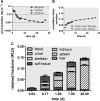Quantitative biokinetics over a 28 day period of freshly generated, pristine, 20 nm titanium dioxide nanoparticle aerosols in healthy adult rats after a single two-hour inhalation exposure
- PMID: 31288843
- PMCID: PMC6617842
- DOI: 10.1186/s12989-019-0303-7
Quantitative biokinetics over a 28 day period of freshly generated, pristine, 20 nm titanium dioxide nanoparticle aerosols in healthy adult rats after a single two-hour inhalation exposure
Abstract
Background: Industrially produced quantities of TiO2 nanoparticles are steadily rising, leading to an increasing risk of inhalation exposure for both professionals and consumers. Particle inhalation can result in inflammatory and allergic responses, and there are concerns about other negative health effects from either acute or chronic low-dose exposure.
Results: To study the fate of inhaled TiO2-NP, adult rats were exposed to 2-h intra-tracheal inhalations of 48V-radiolabeled, 20 nm TiO2-NP aerosols (deposited NP-mass 1.4 ± 0.5 μg). At five time points (1 h, 4 h, 24 h, 7d, 28d) post-exposure, a complete balance of the [48V]TiO2-NP fate was quantified in organs, tissues, carcass, lavage and body fluids, including excretions. After fast mucociliary airway clearance (fractional range 0.16-0.31), long-term macrophage-mediated clearance (LT-MC) from the alveolar region is 2.6-fold higher after 28d (integral fraction 0.40 ± 0.04) than translocation across the air-blood-barrier (integral fraction 0.15 ± 0.01). A high NP fraction remains in the alveoli (0.44 ± 0.05 after 28d), half of these on the alveolar epithelium and half in interstitial spaces. There is clearance from both retention sites at fractional rates (0.02-0.03 d- 1) by LT-MC. Prior to LT-MC, [48V]TiO2-NP are re-entrained to the epithelium as reported earlier for 20 nm inhaled gold-NP (AuNP) and iridium-NP (IrNP).
Conclusion: Comparing the 28-day biokinetics patterns of three different inhaled NP materials TiO2-NP, AuNP and IrNP, the long-term kinetics of interstitial relocation and subsequent re-entrainment onto the lung-epithelium is similar for AuNP and Ir-NP but slower than for TiO2-NP. We discuss mechanisms and pathways of NP relocation and re-entrainment versus translocation. Additionally, after 28 days the integral translocated fractions of TiO2-NP and IrNP across the air-blood-barrier (ABB) are similar and become 0.15 while the translocated AuNP fraction is only 0.04. While NP dissolution proved negligible, translocated TiO2-NP and IrNP are predominantly excreted in urine (~ 0.1) while the urinary AuNP excretion amounts to a fraction of only 0.01. Urinary AuNP excretion is below 0.0001 during the first week but rises tenfold thereafter suggesting delayed disagglomeration. Of note, all three NP dissolve minimally, since no ionic radio-label release was detectable. These biokinetics data of inhaled, same-sized NP suggest significant time-dependent differences of the ABB translocation and subsequent fate in the organism.
Keywords: Accumulation in secondary organs and tissues; Characterization of physicochemical particle properties; Intratracheal inhalation of freshly generated aerosols; Long-term alveolar macrophage-mediated nanoparticle clearance; Nanoparticle relocation into the interstitium; Re-entrainment from interstitium back to lung epithelium for clearance towards the larynx; Spark ignition generated titanium dioxide nanoparticle aerosols; Translocation across air-blood-barrier.
Conflict of interest statement
The authors declare that they have no competing interests. The authors alone are responsible for the content and writing of the manuscript.
Figures













Similar articles
-
Quantitative biokinetics over a 28 day period of freshly generated, pristine, 20 nm silver nanoparticle aerosols in healthy adult rats after a single 1½-hour inhalation exposure.Part Fibre Toxicol. 2020 Jun 5;17(1):21. doi: 10.1186/s12989-020-00347-1. Part Fibre Toxicol. 2020. PMID: 32503677 Free PMC article.
-
Age-Dependent Rat Lung Deposition Patterns of Inhaled 20 Nanometer Gold Nanoparticles and their Quantitative Biokinetics in Adult Rats.ACS Nano. 2018 Aug 28;12(8):7771-7790. doi: 10.1021/acsnano.8b01826. Epub 2018 Aug 15. ACS Nano. 2018. PMID: 30085651
-
Quantitative biokinetics of titanium dioxide nanoparticles after intratracheal instillation in rats: Part 3.Nanotoxicology. 2017 May;11(4):454-464. doi: 10.1080/17435390.2017.1306894. Epub 2017 Apr 3. Nanotoxicology. 2017. PMID: 28290735
-
Significance of particle parameters in the evaluation of exposure-dose-response relationships of inhaled particles.Inhal Toxicol. 1996;8 Suppl:73-89. Inhal Toxicol. 1996. PMID: 11542496 Review.
-
Toxicokinetics of Nanoparticles Deposited in Lungs Using Occupational Exposure Scenarios.Front Public Health. 2022 Jun 21;10:909247. doi: 10.3389/fpubh.2022.909247. eCollection 2022. Front Public Health. 2022. PMID: 35801236 Free PMC article. Review.
Cited by
-
Biodistribution of cerium dioxide and titanium dioxide nanomaterials in rats after single and repeated inhalation exposures.Part Fibre Toxicol. 2024 Aug 14;21(1):33. doi: 10.1186/s12989-024-00588-4. Part Fibre Toxicol. 2024. PMID: 39143599 Free PMC article.
-
Current research on ecotoxicity of metal-based nanoparticles: from exposure pathways, ecotoxicological effects to toxicity mechanisms.Front Public Health. 2024 Jul 15;12:1390099. doi: 10.3389/fpubh.2024.1390099. eCollection 2024. Front Public Health. 2024. PMID: 39076413 Free PMC article. Review.
-
The bio-distribution, clearance pathways, and toxicity mechanisms of ambient ultrafine particles.Eco Environ Health. 2023 Jun 10;2(3):95-106. doi: 10.1016/j.eehl.2023.06.001. eCollection 2023 Sep. Eco Environ Health. 2023. PMID: 38074989 Free PMC article. Review.
-
The internal dose makes the poison: higher internalization of polystyrene particles induce increased perturbation of macrophages.Front Immunol. 2023 May 12;14:1092743. doi: 10.3389/fimmu.2023.1092743. eCollection 2023. Front Immunol. 2023. PMID: 37251378 Free PMC article.
-
Occupational Exposure to Metal Engineered Nanoparticles: A Human Biomonitoring Pilot Study Involving Italian Nanomaterial Workers.Toxics. 2023 Jan 26;11(2):120. doi: 10.3390/toxics11020120. Toxics. 2023. PMID: 36850996 Free PMC article.
References
-
- Industry TN . Titanium Dioxide. vol. Sect. 3.30. pp. 181–186. Edinburgh, London and Sweden: Future Markets Inc; 2013. pp. 181–186.
-
- Maurer MM, Donohoe GC, Maleki H, Yi J, McBride C, Nurkiewicz TR, Valentine SJ. Comparative plasma proteomic studies of pulmonary TiO2 nanoparticle exposure in rats using liquid chromatography tandem mass spectrometry. J Proteome. 2016;130:85–93. doi: 10.1016/j.jprot.2015.09.010. - DOI - PMC - PubMed
Publication types
MeSH terms
Substances
LinkOut - more resources
Full Text Sources
Miscellaneous

